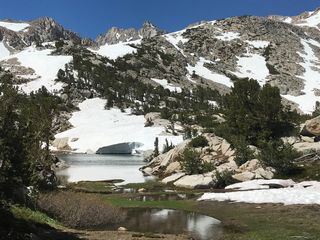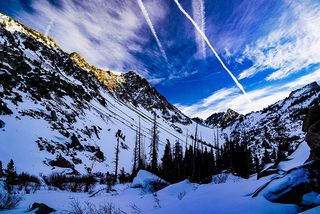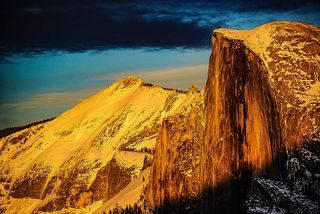Suicide
An Increase in Suicide Rates Among Residents in Ski Towns?
Mental health and substance abuse in mountain towns.
Posted January 24, 2020 Reviewed by Kaja Perina
After moving to Mammoth Lakes, California, a stunningly famous ski town in the Eastern Sierra Nevada mountain range, I started to notice a trend that I could not have predicted. This year is my first living in a ski town. Some things naturally came as a culture shock, shoveling snow all winter long, not having access to Target, seeing the same people daily, and taking a much slower pace in life. One thing, in particular, rattled me to my core, the amount of substance abuse and mental health disorders that are not only prevalent in Mammoth but many other ski towns across the United States. Sadly, it is not uncommon to walk into a bar before noon and see every seat taken, or to hear about a string of suicides that recently occurred. From Vail, South Lake Tahoe, and Jackson to Mammoth Lakes, Sun Valley, and Park City, suicide rates seem to be much higher in ski towns compared to bigger cities and the lack of mental health and substance abuse treatment in these towns is alarming. Ironically many of these places are often listed as the “top places to live in the United States.” They are stunningly beautiful, have a quaint feel, and offer a slow-paced lifestyle; but these places are not for everyone.
40,000 individuals take their own lives each year.
- Eagle County, Colorado, home to the prestigious ski town of Vail, had 15 suicide deaths in 2017. Eagle County has a population of roughly 53,000.
- The Colorado per capita suicide rate was 20.3 per 100,000 residents in 2016, which is well ahead of the national rate of 13.3 suicides per 100,000 in 2015.
- Western states lead the nation in suicide rates per 100,000 residents. The national rate is 13.7, but Wyoming tops the country with 28 followed by Alaska (26.9), Montana (25.3), New Mexico (23.7), Utah (22.4), and Idaho (22.1). Colorado came in 9th (19.5.)
National Geographic published an article with interesting statistics but did not focus on mental health or substance use disorder aspects associated with suicidal ideations.
The Rocky Mountains have the second-highest suicide rate, with Alaska being the first. Wyoming, Montana, Colorado, Idaho, Nevada, and New Mexico consistently rank in the top states for the highest suicide rates, hence why this region in the Rocky Mountains is often known as the "suicide belt", according to National Geographic.
Isolation
Small ski towns are isolating. The lack of crowds and the absence of the hustle and bustle of big cities is what draws people to live in these beautiful mountain towns, especially when most big towns are only a few hours drive to the mountains. Many people move to ski towns to escape, whether they are escaping from the hustle and bustle of a big city or are running away from deeply rooted internal turmoil. The weekends are packed with tourists and when mid-week comes, the towns quickly turn to ghost towns.
I wanted to live a simpler life in the heart of my favorite mountain range, but I gave up my social life as a result. No matter how introverted an individual is, we as humans thrive on social connections. We need to feel loved and wanted, even if we deeply love ourselves and maintain a healthy outlook on life.
Additionally, the transient nature of the ski town community leads to less meaningful relationships and can leave people feeling lonely. It is not uncommon for people to move to a ski town for one season and realize it is not the right fit or find it too hard to thrive and move away. With an influx and outflow of new people, it can be hard to grow roots in the community. This also makes the rental market in a current state of flux.
Living in isolation can contribute to depression and substance abuse. Studies have shown that intergenerational relationships and deep social attachments protect against suicide, and without any form of authentic social connection, we are putting ourselves at risk.
Income disparity
Real estate has been on the upswing in ski towns, especially for second homeowners who are using these properties as an investment via short-term rentals. Short-term rentals such as VRBO and Airbnb have contributed to the increase in property values and the shortage of homes available for first-time homebuyers or long-term renters. The rise in property values has drastically increased the gap between the standard ski town wage and the cost of living, forcing many individuals to live in their cars or leave town. Ski towns thrive on tourism, and individuals who work in the tourism industry must be able to survive on minimum wage plus tips, which is becoming increasingly more difficult when housing prices continue to rise in ski towns across the United States. The mixture of seasonal jobs, the housing crisis, and low paying wages can put a lot of financial strain on most individuals living in ski towns. It is difficult to make a liveable wage in ski towns and even harder to find a long-term affordable rental or be able to save for a down payment on a modest townhome.
As the rich as get richer, the poor get poorer in ski towns because of the housing crisis and low wage jobs. The median sales price of a single-family home in Mammoth Lakes is approximately $900,000, while the estimated per capita income is approximately $50,000. This trend is not only seen in Mammoth Lakes but is seen in ski towns (and touristy small towns) across the U.S.
To make a living in these ski towns, many individuals resort to working two to three jobs and living with multiple roommates. These financial burdens can create feelings of stress and depression, which can also potentially add to the increase in suicide rates.

Mental illness and substance abuse while living in paradise
When I think of Mammoth Lakes, I think of fresh powder, larger than life pine trees, rugged mountain peaks, sparkling alpine lakes, deep red sunsets, and bright colored ski outfits. We ingrain these ideas in our heads of how living in a resort ski town should be, and when these expectations are not met, we can be very let down. Yes, Mammoth Lakes has all of these beautiful things, but I never truly understood the gravity of the isolation, housing crisis, alcoholism, and the lack of mental health care in this town, until I moved here and started to see the reality. Many people assume living in these dreamy ski towns is perfect and are often let down, leaving them confused, angry, and potentially reeling with depression.
There is a bar at every corner in downtown Mammoth and a handful up on the mountain, and as a result, you are just one chair lift away from your next drink. Drinking and using drugs has been an enormous parallel in the ski and snowboard culture, creating nostalgia for a feel-good party lifestyle. “Play hard ski hard,” as many say, usually that “playing” consists of drinking and using. Ski towns are often party towns, as the two seem to go hand in hand.
Depression is always multifactorial, meaning that many underlying triggers can contribute to this mental health disorder. However, loneliness, financial stress, and substance abuse are three common factors that often go hand-in-hand with depression. Substance abuse, whether it is alcohol use disorder, opioid use disorder, or cocaine abuse can contribute to the development of depression and anxiety, often creating the need to use more as a way to curb these unwanted feelings.
On the other hand, mental health disorders such as depression and anxiety can trigger the need to use alcohol and drugs as unhealthy coping mechanisms. In a mountain culture that is so accepting of alcohol and drug use, it is easy for many individuals with a mental illness to feel as this is accepted; when it can be life-threatening. The cycle of addiction and mental health continue to repeat until the two become intertwined, formally known as a co-occurring disorder.
It is not normal or healthy to drink every day, despite what the popular ski town culture is prophesizing.
Lack of oxygen
Our brains and bodies need oxygen to function, and most of the ski towns rest at least 8,000 feet above sea level. The higher elevation means there is less oxygen in the air, (specifically the saturation is the same but the partial pressure is affected by altitude) thereby creating an increase in metabolic stress in our bodies, leaving our bodies and brain stressed. Our bodies learn to thrive with a lesser amount of oxygen over time, but there is still research hypothesizing that insufficient oxygen can contribute to depression and anxiety.

Seasonal depression disorder
Seasonal affective disorder (SAD) is a subtype of depression that comes and goes with the changes in seasons. The “winter blues” typically begins in the late fall and early winter and ends around late spring. Ski towns are notorious for dumping snow beginning in late November through April. It is not uncommon in some years, to spend 2-3 hours each day shoveling out your car or walkway until the storm ends. There may be only a couple of days break in between storm cycles in significant snow years. With low temperatures, high snowfall, and limited hours of daylight six months out of the year, many individuals are at risk of SAD. As a mental health professional, this was one of my biggest fears of moving to Mammoth. I have to actively make myself get outside and enjoy the daylight daily as a way to prevent SAD since I can see myself feeling the winter blues if I am not careful. I will not lie; I have spent my fair share of days in bed this winter. Although SAD is more prevalent in Alaska and the Pacific Northwest compared to ski towns in California, we cannot afford to ignore the effects of snow, cold temperatures, and shorter days and how they play a role in mental health in ski towns across the U.S.
Lack of mental health resources
With increasing rates of suicide, depression, and substance abuse, resort ski towns are lagging in access to mental health and substance abuse treatment. Most hospitals in town are focused on ski injuries and broken bones, employing some of the most talented orthopedic surgeons in the country. The urgent care and emergency rooms are usually well funded in case tourists need quick access to care during their vacation, but rarely are psychiatrists, substance abuse counselors, or mental health support groups readily available in these ski towns. Therapists may be available for a hefty fee, but when the average worker in a ski town makes minimum wage, they must choose between paying their rent or taking care of their mental health.
Is the medical community within these mountain towns turning a blind eye to this suicide epidemic? Do the towns not want to shovel out the funding for this vital cause? Is there not enough push from community members? Will the truth carry a stigma if the tourists and the rest of the world found out what really goes on in these ski towns? Is it due to politics?

Finding a solution
I am not sure as to why our town of Mammoth Lakes does not have a walk-in mental health community center that offers free group sessions for depression, anxiety or other mental health disorders while also teaching coping skills and educating on trauma and grief, especially in the wake of these recent string of suicides. How is our community coping in light of what just happened? Or why do we not have a mental health community group where individuals can engage with others, talk to a therapist, and go to a “meeting” when they are feeling triggered. I am also not sure as to why most of these destination ski towns do not have these resources as well.
It is time our community comes together to not only talk about these life-threatening problems but also develop solutions to try to stop the increasing suicide rates that are regularly occurring in our town and across ski towns in the United States.
Below is a list of the few affordable/free resources that are offered in the Eastern Sierra region for substance abuse. Please excuse the language of "alcoholics", as this word is stigmatizing and labeling.
http://easternsierra-aameetings.org/
https://monocounty.ca.gov/behavioral-health/page/wellness-centers
I would love to see more community mental health groups that are free to the community, that talk about coping skills, grief, depression and what to do after a suicide. More needs to be done within these communities. We must stop pushing these issues under the rug, becoming defensive, using stigmatizing language, and saying that "we are doing enough" when clearly we are not.




